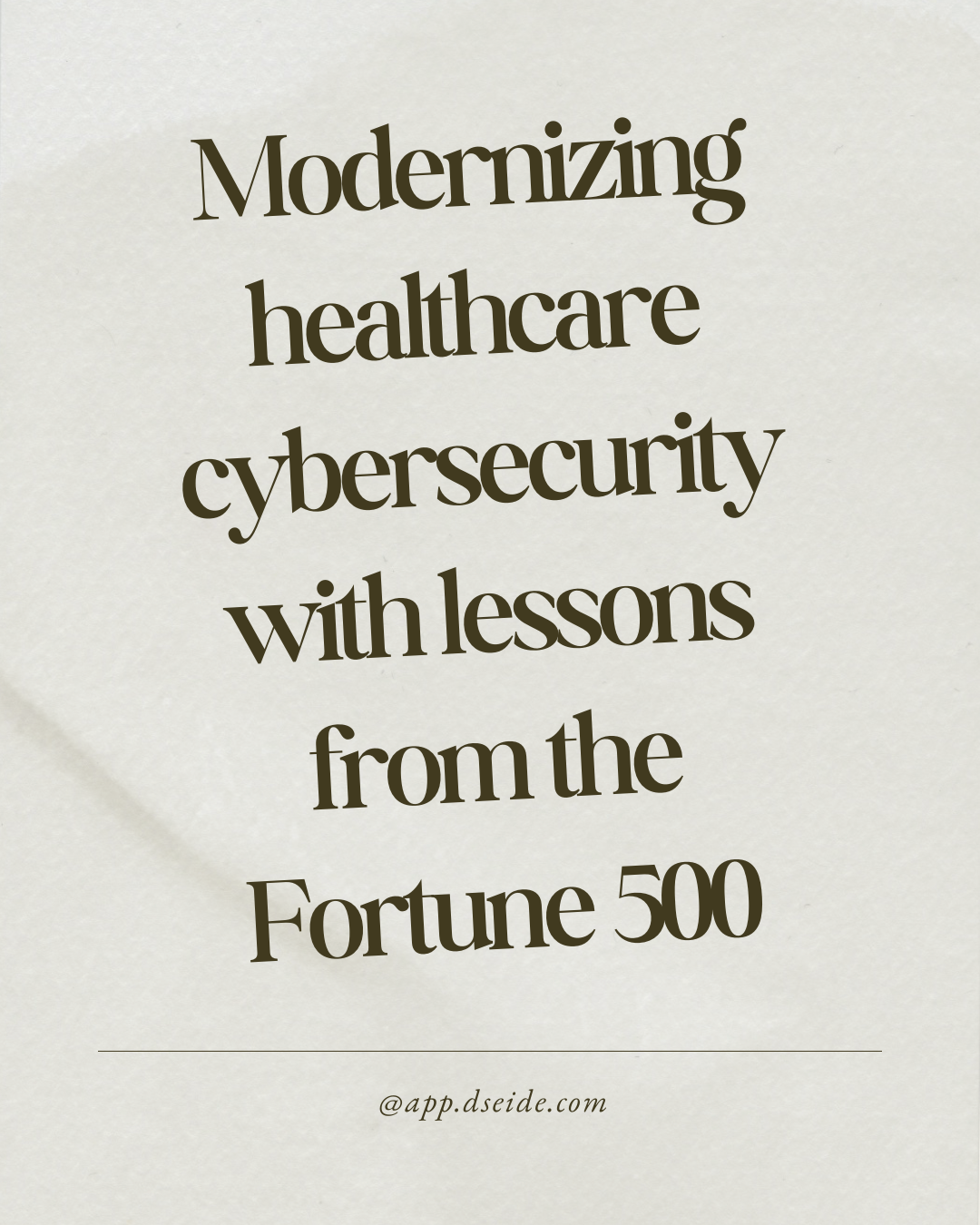Healthcare organizations today face growing cyber threats—from ransomware attacks to data breaches targeting patient records. With outdated systems and limited IT resources, many struggle to keep pace. In contrast, Fortune 500 companies have invested heavily in robust cybersecurity strategies. So, what can healthcare leaders learn from them?
Zero Trust Architecture
Lesson: Fortune 500 firms adopt "never trust, always verify" models to prevent lateral movement of attackers within systems.
Healthcare Takeaway: Implement role-based access, multi-factor authentication, and micro-segmentation.
Proactive Threat Hunting
Lesson: Enterprises actively look for threats using AI and analytics before damage occurs.
Healthcare Takeaway: Invest in Security Operations Centers (SOCs) or partner with managed detection and response (MDR) providers.
Employee Cyber Hygiene Training
Lesson: Regular phishing simulations and awareness training are core in Fortune 500 firms.
Healthcare Takeaway: Train staff across departments—clinicians, admin, IT—to spot and report threats.
Real-Time Incident Response Playbooks
Lesson: Fortune 500s run frequent cyber drills and have pre-approved breach response plans.
Healthcare Takeaway: Prepare for worst-case scenarios with defined roles, communication protocols, and backup systems.
Vendor Risk Management
Lesson: Enterprises assess third-party vendors thoroughly.
Healthcare Takeaway: Conduct cybersecurity audits on EHR providers, telemedicine platforms, and IoT medical device vendors.
Cloud Security Best Practices
Lesson: The cloud isn’t inherently secure—leading companies apply encryption, access control, and regular audits.
Healthcare Takeaway: Apply HIPAA-compliant cloud configurations and encrypt PHI (protected health information).
SOURCE- CIO
#HealthcareCybersecurity #CyberSecurity #DigitalHealthSecurity
#DataProtection #HealthcareIT #PatientDataSecurity#HealthTech
#ZeroTrust #RansomwareProtection #HIPAACompliance
Zero Trust Architecture
Lesson: Fortune 500 firms adopt "never trust, always verify" models to prevent lateral movement of attackers within systems.
Healthcare Takeaway: Implement role-based access, multi-factor authentication, and micro-segmentation.
Proactive Threat Hunting
Lesson: Enterprises actively look for threats using AI and analytics before damage occurs.
Healthcare Takeaway: Invest in Security Operations Centers (SOCs) or partner with managed detection and response (MDR) providers.
Employee Cyber Hygiene Training
Lesson: Regular phishing simulations and awareness training are core in Fortune 500 firms.
Healthcare Takeaway: Train staff across departments—clinicians, admin, IT—to spot and report threats.
Real-Time Incident Response Playbooks
Lesson: Fortune 500s run frequent cyber drills and have pre-approved breach response plans.
Healthcare Takeaway: Prepare for worst-case scenarios with defined roles, communication protocols, and backup systems.
Vendor Risk Management
Lesson: Enterprises assess third-party vendors thoroughly.
Healthcare Takeaway: Conduct cybersecurity audits on EHR providers, telemedicine platforms, and IoT medical device vendors.
Cloud Security Best Practices
Lesson: The cloud isn’t inherently secure—leading companies apply encryption, access control, and regular audits.
Healthcare Takeaway: Apply HIPAA-compliant cloud configurations and encrypt PHI (protected health information).
SOURCE- CIO
#HealthcareCybersecurity #CyberSecurity #DigitalHealthSecurity
#DataProtection #HealthcareIT #PatientDataSecurity#HealthTech
#ZeroTrust #RansomwareProtection #HIPAACompliance
Healthcare organizations today face growing cyber threats—from ransomware attacks to data breaches targeting patient records. With outdated systems and limited IT resources, many struggle to keep pace. In contrast, Fortune 500 companies have invested heavily in robust cybersecurity strategies. So, what can healthcare leaders learn from them?
Zero Trust Architecture
Lesson: Fortune 500 firms adopt "never trust, always verify" models to prevent lateral movement of attackers within systems.
Healthcare Takeaway: Implement role-based access, multi-factor authentication, and micro-segmentation.
Proactive Threat Hunting
Lesson: Enterprises actively look for threats using AI and analytics before damage occurs.
Healthcare Takeaway: Invest in Security Operations Centers (SOCs) or partner with managed detection and response (MDR) providers.
Employee Cyber Hygiene Training
Lesson: Regular phishing simulations and awareness training are core in Fortune 500 firms.
Healthcare Takeaway: Train staff across departments—clinicians, admin, IT—to spot and report threats.
Real-Time Incident Response Playbooks
Lesson: Fortune 500s run frequent cyber drills and have pre-approved breach response plans.
Healthcare Takeaway: Prepare for worst-case scenarios with defined roles, communication protocols, and backup systems.
Vendor Risk Management
Lesson: Enterprises assess third-party vendors thoroughly.
Healthcare Takeaway: Conduct cybersecurity audits on EHR providers, telemedicine platforms, and IoT medical device vendors.
Cloud Security Best Practices
Lesson: The cloud isn’t inherently secure—leading companies apply encryption, access control, and regular audits.
Healthcare Takeaway: Apply HIPAA-compliant cloud configurations and encrypt PHI (protected health information).
SOURCE- CIO
#HealthcareCybersecurity #CyberSecurity #DigitalHealthSecurity
#DataProtection #HealthcareIT #PatientDataSecurity#HealthTech
#ZeroTrust #RansomwareProtection #HIPAACompliance





